 |
 |
 |
| |
Safety and Tolerability of Filibuvir, a Non nucleoside Inhibitor of HCV Polymerase
|
| |
| |
Reported by Jules Levin
Hep Dart, Dec 6-10, 2009, Hawaii
S. Srinivasan, S. Jagannatha, Y. Cui, N. Volkova, H. Mayer, J.L. Hammond
Specialty Care Business Unit, Pfizer Global Research and Development, New London, CT, USA
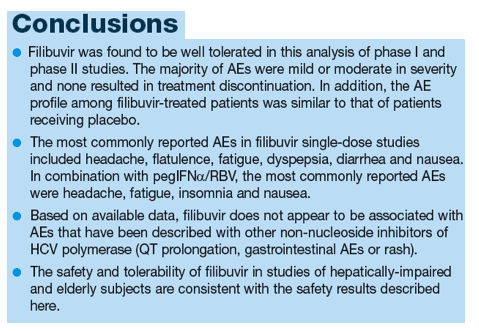
Introduction
Several direct-acting antivirals are currently in development, which when combined with pegylated interferon alfa-2a and ribavirin (pegIFNα/RBV), significantly improve outcomes in patients with chronic hepatitis C virus (HCV) genotype-1 infection.
However, there is concern regarding the safety of these agents, especially when added to standard of care. Hence, it is important to develop therapeutic options that are both well tolerated and efficacious. This abstract reviews the phase I and phase II safety and tolerability data collected to date for filibuvir (PF-00868554).
Background
Filibuvir is a potent, selective non-nucleoside inhibitor of the HCV NS5B RNA-dependent RNA polymerase. Filibuvir exerts its inhibitory effect by binding
in the HCV RNA polymerase 'Thumb 2' site.1
The safety, tolerability, pharmacokinetics and antiviral activity of filibuvir monotherapy have been investigated in healthy volunteers and treatment-naïve HCV-infected patients in dose-ranging studies.
- Mean maximum reductions in HCV RNA levels of -0.97 to -2.13 (log10 IU/mL) were observed over 8 days with filibuvir 100-450 mg BID and 300 mg TID in patients infected with HCV genotype-1.2
In a recently completed phase IIa study, up to 75% of treatment-naïve HCV-infected patients treated with filibuvir 200, 300 or 500 mg BID in combination with pegIFNα/RBV achieved undetectable HCV RNA levels by Week 4 (Rapid Viral Response).3
Objectives
To review safety and tolerability data from filibuvir phase I and phase II studies to date, including adverse-event (AE) incidence, laboratory abnormalities and electrocardiogram (ECG) findings.
Methods
Study details
The eight studies included in this analysis are summarized in Table 1.
- Five single-agent filibuvir studies in healthy volunteers and two single-agent filibuvir studies in HCV-infected patients.
- A combination study (filibuvir plus pegIFNα/RBV) in HCV-infected patients (Figure 1).3
All study protocols were reviewed and approved by an independent ethics committee, and all subjects provided written informed consent.
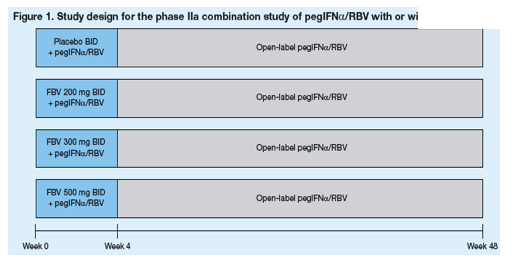
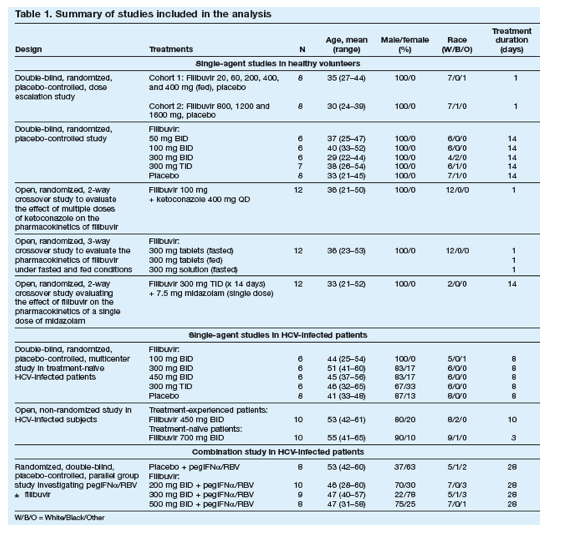
Safety and tolerability assessments
Safety and tolerability in all studies were assessed through physical examinations, AE monitoring, clinical laboratory tests and ECG.
Results
Subjects/patients
This analysis included 148 healthy volunteers and HCV-infected patients who received at least one dose of filibuvir in completed phase I and phase II studies, representing 55.8 patient-months of exposure to filibuvir.
- Single-agent studies: 77 healthy volunteers and 44 HCV-infected patients received filibuvir (20.7 and 10.7 patient-months of exposure, respectively).
-- Combination study (filibuvir + pegIFNα/RBV): 27 HCV-infected patients received filibuvir (24.4 patient-months of exposure).
Adverse event incidence
Filibuvir was found to be generally well tolerated in all studies, with most AEs of mild or moderate severity. No discontinuations due to AEs were reported with filibuvir.
Treatment-emergent all-causality AEs with single-agent filibuvir are summarized in Table 2. The most frequently reported AEs across filibuvir doses were headache, flatulence, fatigue, dyspepsia, diarrhea and nausea.
The incidence and severity of these events did not appear to increase with filibuvir dose. In addition, all AEs were mild or moderate in severity, with the exception of one severe AE of peritonsillar abscess with filibuvir 1200 mg (single-dose), which was not considered to be related to treatment.
In combination with pegIFNα/RBV, the most frequently reported treatment-emergent all-causality AEs included headache, fatigue, insomnia and nausea Table 3. Consistent with the single-dose studies, there were no trends towards increased frequency or severity of AEs with increased dose of filibuvir. There were no discontinuations due to AEs in the first 4 weeks of the combination study.
One serious AE (elevated creatinine)was reported in the combination study. The event occurred in a 58-year-old female patient with a past medical history of diabetes mellitus, hypertension and depression who started treatment with pegIFNα/RBV and filibuvir 300 mg BID (blinded). On Day 2, this patient experienced severe nausea, vomiting and chills and hence stopped all treatment. On Day 7, the patient withdrew from the study and was brought in the following week for an early termination visit. At the time of this
visit, the patient was found to have a serum creatinine of 5.4 mg/dL and a BUN of 90 mg/dL. Blood pressure, ECG and electrolytes were within normal limits. The AE resolved with aggressive hydration and was considered likely to be prerenal azotemia.
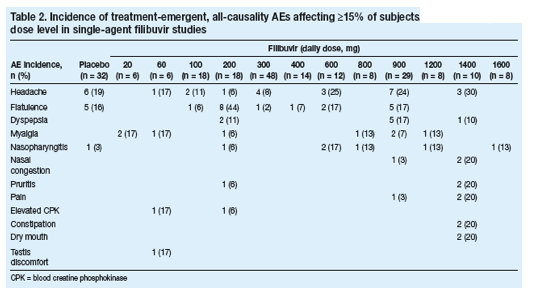
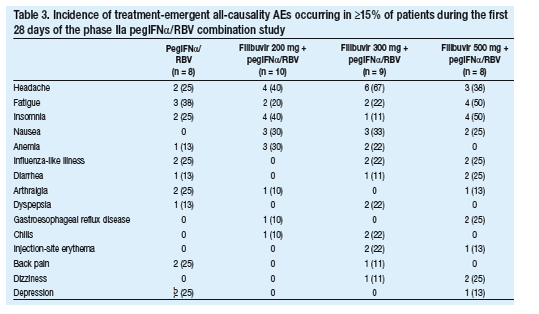
Laboratory abnormalities
All hematology, liver, and renal function test abnormalities were ≤Grade 2 in severity across the single-agent filibuvir studies, in healthy subjects and in HCV-infected patients (Table 4). The incidence of laboratory abnormalities did not appear to be related to filibuvir dose.
In the combination study of filibuvir with pegIFNα/RBV, the incidence and severity of laboratory abnormalities and the change from baseline in key hematology parameters was similar to that reported in patients receiving pegIFNα/RBV alone (Figure 2; Table 5).
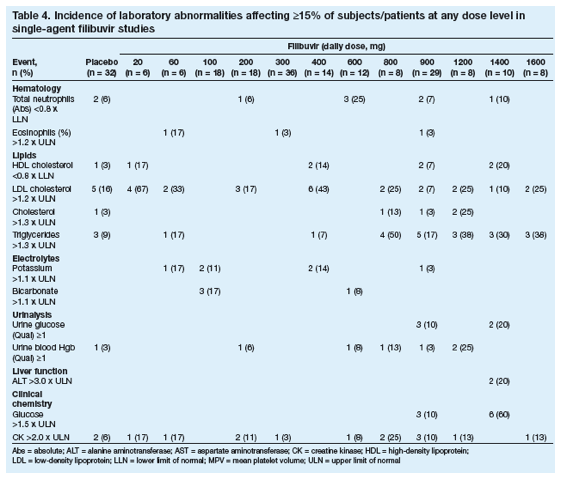
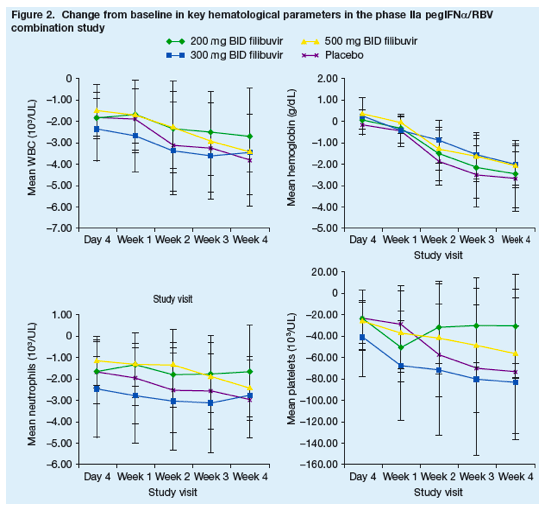
Electrocardiograms
All 148 subjects receiving filibuvir had baseline and follow-up ECGs. Across all studies and at all doses of filibuvir, no patients experienced a >30 msec increase in QTcF from baseline or a QTcF value >480 msec.
The mean change in QTcF from baseline was <10 msec at all timepoints post-dose for all filibuvir doses evaluated.

References
1. Shi ST, et al. Preclinical characterization of PF-00868554, a potent nonnucleoside inhibitor of the hepatitis C virus RNA-dependent RNA polymerase. Antimicrob Agents Chemother 2009;53:2544-2552.
2. Hammond JL, et al. Antiviral activity of the HCV polymerase inhibitor PF-00868554 administered as monotherapy in HCV Genotype 1 infected subjects. Poster LB11 presented at the 59th Annual Meeting of the American Association for the Study of Liver Diseases, October 31-November 4, 2008, San Francisco, USA.
3. Jacobson I, et al. Antiviral activity of filibuvir in combination with pegylated interferon alfa-2A and ribavirin for 28 days in treatment naïve patients chronically infected with HCV genotype 1. Poster 1052 presented at the 44th Annual Meeting of the European Association for the Study of the Liver, April 22-26, 2009, Copenhagen, Denmark.
|
| |
|
 |
 |
|
|